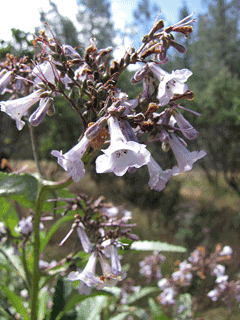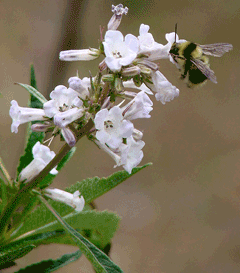 |
|
http://flickr.com/photos/58096907%40N00/ |
 |
| http://flickr.com/photos/58096907%40N00/ |
Translate this page:
Summary
Physical Characteristics

 Eriodictyon californicum is an evergreen Shrub growing to 2.3 m (7ft) by 2 m (6ft).
Eriodictyon californicum is an evergreen Shrub growing to 2.3 m (7ft) by 2 m (6ft).
See above for USDA hardiness. It is hardy to UK zone 8. It is in leaf all year, in flower from July to August. The species is hermaphrodite (has both male and female organs).
Suitable for: light (sandy) soils and prefers well-drained soil. Suitable pH: mildly acid, neutral and basic (mildly alkaline) soils. It cannot grow in the shade. It prefers dry or moist soil.
UK Hardiness Map
US Hardiness Map
Synonyms
Eriodictyon glutinosum Benth. Eriodictyon trichocalyx A.Heller.
Plant Habitats
South Wall. By. West Wall. By.
Edible Uses
Edible Parts: Leaves
Edible Uses: Condiment Tea
The fresh leaves are chewed for their refreshing taste and to relieve thirst[183]. An aromatic sweet tea is made from the fresh or dried leaves[183]. An extract of the leaves is used as a flavouring in baked goods, sweets, ice cream and soft drinks[183].
References More on Edible Uses
Medicinal Uses
Plants For A Future can not take any responsibility for any adverse effects from the use of plants. Always seek advice from a professional before using a plant medicinally.
Antiasthmatic Expectorant Pectoral Tonic
Yerba Santa (the name means Holy weed) is a famous domestic remedy from south-western N. America where it is considered to be especially useful as an expectorant[238]. It is an ingredient of many patent cough medicines[238]. The leaves are an aromatic pleasant tasting tonic herb that reduces spasms, expels phlegm and lowers fevers[238, 254]. They are especially recommended for treating diseases of the chest and respiratory system, including asthma, and are also used in the treatment of hay fever[4, 200, 238]. A bitter tea made from the leaves has been much used as a bitter tonic and a stimulating balsamic expectorant[207, 213]. A steam bath made from the branches and leaves has been used in the treatment of rheumatism[257]. A decoction of the leaves has been used as a wash for sore areas and painful fatigued limbs[257]. A natural mouthwash is prepared by rolling the leaves into balls and allowing them to dry in the sun[213]. These are then chewed and at first have a bitter flavour but this is soon replaced by a sweetness if a drink of water is taken[213]. The leaves are harvested in the summer and dried for later use[238]. The plant has been smoked as a remedy for asthma[213].
References More on Medicinal Uses
The Bookshop: Edible Plant Books
Our Latest books on Perennial Plants For Food Forests and Permaculture Gardens in paperback or digital formats.

Edible Tropical Plants
Food Forest Plants for Hotter Conditions: 250+ Plants For Tropical Food Forests & Permaculture Gardens.
More

Edible Temperate Plants
Plants for Your Food Forest: 500 Plants for Temperate Food Forests & Permaculture Gardens.
More

More Books
PFAF have eight books available in paperback and digital formats. Browse the shop for more information.
Shop Now
Other Uses
References More on Other Uses
Cultivation details
Requires a position in full sun in a well-drained sandy soil[200]. This species is not hardy in the colder areas of the country, it tolerates temperatures down to about -5°c[200]. It is probably best grown against a sunny wall. If the plant needs pruning to keep it within bounds, then this is best carried out in spring or early summer. Do not cut back to wood more than 2 years old[238]. This plant is remarkable for the coating of varnish-like resin that covers the upper leaf surface[200]. The foliage is very aromatic[200].
References Carbon Farming Information and Carbon Sequestration Information
Temperature Converter
Type a value in the Celsius field to convert the value to Fahrenheit:
Fahrenheit:
The PFAF Bookshop
Plants For A Future have a number of books available in paperback and digital form. Book titles include Edible Plants, Edible Perennials, Edible Trees,Edible Shrubs, Woodland Gardening, and Temperate Food Forest Plants. Our new book is Food Forest Plants For Hotter Conditions (Tropical and Sub-Tropical).
Shop Now
Plant Propagation
Seed - sow spring in a greenhouse[200]. Prick out the seedlings into individual pots when they are large enough to handle. Grow on the young plants for at least their first winter in a greenhouse and plant out in late spring or early summer. Give some protection from the cold for at least their first couple of winters outdoors.
Other Names
If available other names are mentioned here
Native Range
NORTHERN AMERICA: United States (Oregon (southwest), California)
Weed Potential
Right plant wrong place. We are currently updating this section.
Please note that a plant may be invasive in one area but may not in your area so it's worth checking.
Conservation Status
IUCN Red List of Threatened Plants Status :

Growth: S = slow M = medium F = fast. Soil: L = light (sandy) M = medium H = heavy (clay). pH: A = acid N = neutral B = basic (alkaline). Shade: F = full shade S = semi-shade N = no shade. Moisture: D = dry M = Moist We = wet Wa = water.
Now available:
Food Forest Plants for Mediterranean Conditions
350+ Perennial Plants For Mediterranean and Drier Food Forests and Permaculture Gardens.
[Paperback and eBook]
This is the third in Plants For A Future's series of plant guides for food forests tailored to
specific climate zones. Following volumes on temperate and tropical ecosystems, this book focuses
on species suited to Mediterranean conditions—regions with hot, dry summers and cool, wet winters,
often facing the added challenge of climate change.
Read More
Expert comment
Author
(Hook. & Arn.) Decne.
Botanical References
200
Links / References
For a list of references used on this page please go here
Readers comment
| Add a comment |
|
If you have important information about this plant that may help other users please add a comment or link below. Only comments or links that are felt to be directly relevant to a plant will be included. If you think a comment/link or information contained on this page is inaccurate or misleading we would welcome your feedback at [email protected]. If you have questions about a plant please use the Forum on this website as we do not have the resources to answer questions ourselves.
* Please note: the comments by website users are not necessarily those held by PFAF and may give misleading or inaccurate information.
To leave a comment please Register or login here All comments need to be approved so will not appear immediately.
|
Subject : Eriodictyon californicum
|
|
|
|